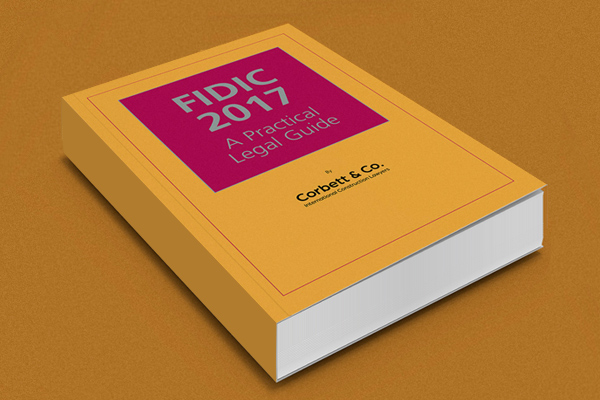The 12 Worst Things About FIDIC 2017 – A Christmas Special
The FIDIC 2017 forms first appeared at the December FIDIC Users’ Conference four years ago. No one has suggested that the FIDIC 2017 forms of contract did not rectify some of the problems in the FIDIC 1999 forms, and in Edward Corbett’s articles,[1] ‘Cherry Picking FIDIC 2017,’ and ‘FIDIC 2017 – First Impressions of the 3-Kilo Suite’, he considered some of these changes. This new suite of contracts had, at best, a lukewarm reception when they were first reviewed, with some commentators complaining about the length of these new contracts and that the contracts had not taken account of criticisms that had been made by reviewers. This article looks at the twelve worst ‘gifts’ that FIDIC gave to us for Christmas 2017.
FIDIC’s New Green Form: The Missing Link
In December 2021 FIDIC issued its 2nd edition of the Green Book. It is not so much an update to the 1st edition as a new and improved, intermediate form of contract. FIDIC is promoting it as a simpler, user-friendly alternative to the FIDIC 2017 Red and Yellow Books, where significant contract administration and management resources are not needed. The Green Book 2nd edition is recommended to be used by the World Bank for projects up to US$ 10 million. The Green Book 1st edition was originally intended for projects of US $500,000 with no more than a 6-month duration. However, the Green Book 1st was sometimes used for larger projects with a duration of up to two years. The Green Book 2nd therefore takes over from where the Green Book 1st left off. This is to be welcomed. The FIDIC 2017 suite of contracts (Red/Yellow/Silver) is unsuitable for smaller projects where less administration is required. The Green Book 2nd will therefore fill a much-needed gap in the FIDIC rainbow and is likely to be attractive to both Contractors and Employers. This article looks at some of the key features of the Green Book 2nd.
On-Demand Bonds, Injunctions and FIDIC Contracts
Bonds and guarantees will usually be required in any major construction project and they are a requirement within FIDIC standard forms. An on-demand bond is a security that unconditionally requires a Bank or other surety to pay to the beneficiary a sum of money once a demand has been made and, on occasion, on the presentation of certain documents. This can be contrasted with a normal guarantee which will usually require the beneficiary to prove a liability against the obligor/debtor who has the benefit of the guarantee. These normal types of guarantees are commonly referred to as “see to it” guarantees.[1]
Arbitration Update 2021
The last year or two has seen changes in arbitration rules and procedures, caused in no small part by the COVID-19 pandemic. There are new LCIA, DIFC-LCIA and ICC arbitration rules. The Seoul Protocol on Video Conferencing in International Arbitration is being regularly used and the Africa Arbitration Academy Protocol on Virtual Hearings has been issued. There have also been revisions to the IBA Rules on Taking Evidence in International Arbitration. This short update looks at the key take-aways from these changes.
Jurisdiction, Admissibility and FIDIC
An issue that often arises in international arbitrations involving the FIDIC forms of contract is whether a claimant's failure to: (a) go through the dispute resolution provisions; or (b) comply with a time-bar clause gives rise to a question of admissibility or jurisdiction. Put another way, if a claimant has failed to issue a notice of claim within 28 days or failed to refer a dispute to a DAB, does the arbitral tribunal have jurisdiction to make an award on the merits or should the arbitral tribunal make an award stating that it lacks jurisdiction?
FIDIC’s Emerald Book – A contractor’s charter or optimum risk allocation?
It has been suggested that FIDIC’s new Emerald Book may be “a contractors’ charter for riches”. 1 This article examines whether this new form of contract for underground works by FIDIC and the International Tunnelling and Underground Space Association is too contractor-biased or whether it provides a sensible and pragmatic risk allocation process, in an area of construction and engineering which is well known for claims. If more risks are placed on the Employer in this form of contract, what are the benefits of the contract compared to, for example, an unamended FIDIC Yellow Book?
Arbitration in a Post-Brexit World
This article considers what the arbitration landscape will look like when (or perhaps if!) the UK leaves the EU and concludes that big changes are unlikely.
FIDIC 1999 Books – Commentary on Clause 17
Although Clause 17 is titled ‘Risk and Responsibility’ it also sets out other provisions relating to indemnities, limitation of liability and, unusually, the specific topic of intellectual and industrial property rights. The clause provides that the Contractor assumes responsibility and bears the risk for the care of the works during execution and for remedying any defects during the Defects Notification Period. Risk transfers to the Employer on issue of the Taking–Over Certificate to the extent of works defined as being completed. Generally, in construction contracts ‘risk’ is understood to mean an event or circumstance which causes delay, loss or damage to the Works. A risk can be said to be Employer caused, Contractor caused or neutral. The purpose of risk allocation is to determine which party bears the risk for such events. The Contractor may be required to remediate the damage at his own cost or the Employer may be required to pay for the damaged works. It has been stated that the “FIDIC standard forms are generally recognised as being well balanced because both parties bear parts of the risks arising from the project.”
FIDIC 1999 Books – Commentary on Clause 8
Clause 8 contains all the fundamental provisions relating to the start of the Works, the Time for Completion, delays and the entitlement of the Contractor to an extension of time and of the Employer to delay damages, and finally the circumstances in which a suspension of the Works can occur and the implications for the Parties.
FIDIC 1999 Books – Commentary on Clause 7
Click through to read Corbett & Co.'s helpful commentary on FIDIC Red Book 1999 book - Clause 7
FIDIC 1999 Books – Commentary on Clause 6
Clause 6 deals with Staff and Labour. These provisions need to be read with the applicable laws where the works are being carried out or the relevant employment law if different. Sub-Clause 6.1 commits the Contractor (unless otherwise specified) to pay for his staff and their housing feeding and transport. Sub-Clause 6.2 requires the Contractor not to pay lower wages or give lower conditions than those generally applicable locally. Sub-Clause 6.3 forbids the Contractor from attempting to recruit from the Employer’s Personnel. Sub-Clause 6.4 requires the Contractor to abide by labour laws and to require his staff to obey the law generally. Sub-Clause 6.5 forbids work on locally recognised rest days or outside the working hours set out in the Appendix to Tender, unless stated in the Contract or agreed to by the Engineer or essential for the protection of life or property or for safety reasons. Sub-Clause 6.6 requires the Contractor to provide and maintain all necessary accommodation for its personnel and for the Employer’s personnel to the extent stated in the Specification. It is forbidden from permitting its own Personnel from living within the structures forming part of the Permanent Works. Sub-Clause 6.7 requires the Contractor to maintain the health and safety of its personnel and maintain proper medical facilities for its own personnel and for any Employer Personnel accommodated. It is required to appoint an accident prevention officer. It is required to notify the Employer of any accidents and maintain records. Sub-Clause 6.8 requires the Contractor to provide all necessary superintendence by a sufficient number of properly qualified people with adequate knowledge of the defined language of communications. Sub-Clause 6.9 requires the Contractor to ensure that its personnel are properly qualified, skilled and experienced. The Employer may require the Contractor to remove any person employed on the Site or the Works who commits misconduct, is incompetent or negligent, fails to perform in accordance with any provision of the Contract or persists in any conduct prejudicial to health, safety or the environment. If a person is removed the Contractor will have to replace him. Sub-Clause 6.10 requires the Contractor to submit to the Engineer details showing personnel and equipment on Site. This is required each month and must be in a form approved by the Engineer. Sub-Clause 6.11 requires the Contractor to take reasonable precautions to prevent disorderly conduct by Contractor’s Personnel and to preserve the peace and protection or nearby persons and property.
Fitness for Purpose Højgaard and FIDIC’s Yellow Books
MT Højgaard AS v E.ON Climate and Renewables UK Robin Rigg East Ltd & Anor is an important English case because it considered a fitness for purpose obligation in a design and build contract. In FIDIC’s Yellow Book contracts (1999 and 2017) there are also fitness for purpose obligations. This article examines the Supreme Court’s analysis of a fitness for purpose obligation in the Højgaard case and whether it would be applied to FIDIC’s Yellow Book contracts.
Clause 10 – Employers Taking Over
The main changes in Clause 10 are the express reference in Sub-Clause 10.1 [Taking Over the Works and Sections] to the supply of As-Built Records, Operation and Maintenance Manuals and Training as a requirement of Taking Over.
FIDIC 1999 Books – Commentary on Clause 19
Clause 19 deals with two distinct events: (1) Force Majeure; and (2) release from performance under the law. Force Majeure is often narrowly defined under the laws of many countries; however, within the FIDIC 1999 forms of contract it has a much broader meaning. The terminology used by FIDIC has therefore sometimes been criticized as being misleading.
All Damage Is In A Sense Consequential – So What In Law Are Consequential Losses?
Sub-Clause 17.6 of FIDIC’s Red, Yellow and Silver Book is an exemption clause and provides in the opening paragraph that: “Neither Party shall be liable to the other Party for loss of use of any Works, loss of profit, loss of any contract or for any indirect or consequential loss or damage which may be suffered by the other Party in connection with the Contract…” The phrase ‘indirect or consequential loss or damage’ has been examined by the English courts on numerous occasions. Historically the words ‘consequential loss’ were held to be synonymous with ‘indirect loss’. However, a recent case questions whether this will be correct in all cases.
FIDIC 1999 Books – Commentary on Clause 15
Click through to read Corbett & Co.'s helpful commentary on FIDIC 1999 book Clause 15
FIDIC 1999 Books – Commentary on Clause 16
Clause 16 deals with suspension and termination by the Contractor. Sub-Clause 16.1 deals with the Contractor’s right to suspend work in the event that the Engineer fails to certify in accordance with Sub-Clause 14.6 [Payment Certificates] or the Employer fails to comply with Sub-Clause 2.4 [Employer’s Financial Arrangements] or Sub-Clause 14.7 [Payment]. Prior to the Contractor suspending work it must give 21 days’ notice. The right to suspend does not affect the Contractor’s entitlement to terminate or claim financing charges. In the event that the Contractor suffers delay or cost as a result of suspension it must give notice under Sub-Clause 20.1 [Contractor’s Claims]. Sub-Clause 16.2 deals with the Termination by the Contractor. There are seven grounds specified. In most cases the Contractor may give 14 days’ notice if it intends to terminate the contract; however, where there has been a prolonged suspension under Sub-Clause 8.11 [Prolonged Suspension] or, inter alia, bankruptcy, liquidation, insolvency or receiving or administration orders have been made against the Employer then the Contractor may by notice terminate immediately. Sub-Clause 16.3 deals with Cessation of Work by the Contractor and Removal of the Contractor’s Equipment. This Sub-Clause applies where the termination takes place under Sub-Clause 15.5 [Employer’s Entitlement to Termination]; Sub-Clause 16.2 [Termination by Contractor]; or Sub-Clause 19.6 [Optional Termination, Payment and Release]. Sub-Clause 16.4 deals with Payment on Termination. Once termination under Sub-Clause 16.2 [Termination by Contractor] has taken effect then the Contractor is entitled to the return of the Performance Security; payment in accordance with Sub-Clause 19.6 [Optional Termination, Payment and Release] and loss of profit or other loss and damage sustained by the contractor as a result of termination.
FIDIC 1999 Books – Commentary on Clause 4
Clause 4 sets out various obligations which fall on the Contractor under the Contract and which cannot easily be classified elsewhere. The obligations under Clause 4 are of a wide range covering 24 different topics. Sub-Clause 4.1 sets out the Contractor’s general obligation to carry out his duties in accordance with the contract. Clause 4 of the FIDIC Red Book 1999 amalgamates various Contractor obligations under one provision. However this Clause 4 is not exclusive as there are also other Contractor obligations scattered throughout the Contract. Other significant general obligations which could equally have been included in Clause 4 (and which should be read in conjunction with this Clause 4) are as follows: • Sub-Clause 1.3 [Communications] • Sub-Clause 1.7 [Assignment] • Sub-Clause 1.8 [Care and Supply of Documents] • Sub-Clause 1.9 [Delayed Drawings or Instructions] • Sub-Clause 1.10 [Employer’s Use of Contractor’s Documents] • Sub-Clause 1.12 [Confidential Details] • Sub-Clause 1.13 [Compliance with Laws] • Clause 6 [Staff and Labour] • Clause 7 [Plant, Materials and Workmanship] • Sub-Clause 8.2 [Time for Completion] • Sub-Clause 8.3 [Programme]
Unjust Enrichment and Construction Contracts – A Cinderella Story?
Two decades ago, unjust enrichment was described as “the Cinderella of law, barely 10 years old but growing up rapidly. Until recently unrecognised and overshadowed by the ugly sisters, Contract and Tort, Cinderella’s day has arrived.” In England a claim for unjust enrichment was initially referred to as a claim in ‘quasi contract’. This language has now been abandoned and unjust enrichment has a strong foothold in the landscape of commercial law and its role and limits are becoming more clearly defined. Despite this, it is only infrequently pleaded in construction cases and when argued it is often set out in broad terms where the facts do not support such a claim. However, this is cause of action that should not be overlooked by a contractor or employer – especially if they have claims that fall outside the four corners of their construction contract.
FIDIC 1999 Books – Commentary on Clause 13
Sub-Clause 13.1 deals with the right of the Engineer to vary the Contract. This right can be exercised at any time up to the issue of the Taking-Over Certificate. Sub-Clause 13.2 deals with value engineering and permits the Contractor to propose a change which will benefit the Employer. The proposal is prepared at the cost of the Contractor, who designs the change. Sub-Clause 13.3 deals with the procedure prior to the Engineer instructing a variation. The Engineer may request a proposal from the Contractor. However, while the Contractor is preparing the proposal it must proceed with the works. Sub-Clause 13.4 deals with payment in applicable currencies. Sub-Clause 13.5 deals with Provisional Sums and ought to be read with Sub-Clause 1.1.4.10 which defines Provisional Sum as follows:- “a sum (if any) which is specified in the Contract as a provisional sum, for the execution of any part of the Works or for the supply of Plant, Materials or services under Sub-Clause 13.5 [Provisional Sums].” The Provisional Sum can only be used where there is an Engineer’s instruction and the Contractor receives payment for only the work done to which the Provisional Sum relates. Sub-Clause 13.6 deals with daywork. This is where work of a minor or incidental nature is to be carried out. The work is then valued in accordance with the Daywork Schedule in the Contract or if there is no Daywork Schedule then the alternative method of payment as prescribed in the Contract. Sub-Clause 13.7 deals with the Cost arising from changes in the Laws of the Country which affect the Contractor in performance of his obligations under the Contract. Where the Contractor suffers delay or additional Cost then it must give notice under Sub-Clause 20.1 of the Contract. Sub-Clause 13.8 deals with adjustments for changes in cost. This Sub-Clause only applies where the “table of adjustment data” included in the Appendix to Tender has been completed. If the Sub-Clause does apply then the amounts payable to the Contractor for rises and fall in the cost of the Works are adjusted by a formula.








